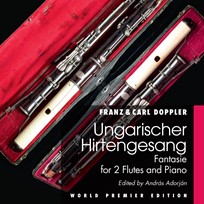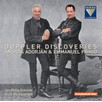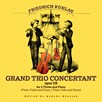
Ungarischer Hirtengesang - Fantasie (WORLD PREMIER EDITION)
Composer: Franz&Carl Doppler
Instrument: 2 Flutes and Piano
Level: Advanced
Published: 2019
Price: €28.00
Item details
-
Description +
-
Duration: ca. 9'30''
Edited by András Adorján
Performing artists:
András Adorján & Emmanuel Pahud, Flute
Jan Philip Schulze, Piano
from CD „Doppler Discoveries“ FARAO classics B 108104 – CD ref. 070.170
http://www.farao-classics.de
The Ungarischer Hirtengesang (Chant pastoral hongrois) for two flutes and piano represents most likely the original version of Franz Doppler’s most popular flute composition, his Fantaisie pastorale hongroise, opus 26. From 1856 on this jointly composed fantasy often figured on the brothers’ concert programs and was always annonced as composed and performed by Franz and Carl Doppler. As only the handwritten solo parts have survived, the piano accompaniment has been reconstructed by Jan Philip Schulze.
-
-
Instrumentation +
-
2 Flutes and Piano
-
-
About the composer +
-
Franz (1821-1883) and Carl (1825-1900) Doppler were among the best-known musicians of their time. They were both born in Lemberg but lived from 1838 in Hungary. They started their solo career in 1852 as a remarkable flute duo, playing jointly composed pieces. In 1858 Franz was appointed first flute and ballet conductor at the Vienna Hofoper, and in 1865 he also became a professor for flute at the Vienna Conservatory. In 1865 Carl was named music director at the Stuttgart Opera, where he stayed for more than thirty years as a popular music director. Besides their flute music, which they had written jointly in their youth, both brothers left independently composed operas, stage and ballet music, which were played with great success for many years, but are entirely forgotten and remain unknown to this day.
-
-
Reviews +
-
Pan November 2019
The two hundredth anniversary of Doppler’s birth is coming up in 2021, and this is perhaps an important element in the emergence of a renewed interest in his music. Two major projects are underway in relation to his flute music; one is a complete recording of his flute music, spearheaded by Claudi Arimany, involving a whole host of well-known players, and the other is András Adorján’s project with Edition Svitzer to make new editions of the repertoire available to the public.
The Grande Fantaisie appears here in its first modern edition; an early piece, thought to have been written in 1850 and not possessing the Hungarian influences we are used to hearing in his later works, it is likely that it would have been performed in a version with orchestra as well as in this flute and piano version.The opening has a familiar introduction, theme and variations format, and Adorján provides some suggestions regarding the source of the theme in his Foreword. The second part of the piece comes in the form of a Bolero.
At a little over 13 minutes duration, and full of the customary rapid arpeggios, displays of virtuosity across the whole range of the flute and moments of tender lyricism, this is an enjoyable work with a good range of challenges (musical and technical) which makes it a suitable recital alternative to the more familiar Hungarian Pastoral Fantasy. The piano part is essentially accompanimental in nature and doesn’t have the same challenges as the flute part, but still contains a few moments of melodic interest.The music is clearly typeset and presented with good consideration to the position of page turns, and the flute part contains some helpful piano cues. This is an enjoyable addition to the repertoire which, although perhaps lacking any great emotional depth, is likely to provide a lot of fun for both advanced players and audiences alike.
– Carla Rees
________Doppler: New Works
Variations, Ungarischer Hirtengesang Fantasie, Grande Fantaisie, Aus der HeimatFranz and Carl Doppler
2019 Edition Svitzer
The Doppler Effect has been given a new lease on life! The acoustic and visual examples of this phenomenon can be heard with the scream of a siren approaching and departing or seen by astronomers in the red shift in the movement of celestial bodies. But the musical appeal to flutists worldwide of Franz and Carl Doppler (often dubbed the Doppler brothers) is akin to an irresistible magnet, and now new publications of works for one or two flutes(s) and piano are available for maximum attraction.
Edition Svitzer has published four „new“ Doppler works: a set of variations by Carl Doppler, „Fantaisie“ by both Dopplers, „Grande Fantaiise“ for flute and piano, and Aus der Heimat, a wide-ranging international excursion for two flutes and piano. For each, Adorján has provided fascinating historical context and photos of performance title pages or first editions.
Carl Doppler’s Variations on a Hungarian Air (Variations sur un air hongrois) reflects its cultural roots and provides fresh insight into what made the Dopplers’ music so recognizable as coming from their pens.
Both brothers collaborated on their Fantasy on Hungarian Pastoral Songs (Ungarischer Hirtengesang, Fantasie) for two flutes and piano. The preface for this edition includes a concert program given by both brothers in 1856, of which this work was the opening selection. A bonus offering in Adorján’s introduction is a manuscript copy of the first page of the second flute part. Cues in the flute parts indicate a violin line, suggesting that at some point, Franz and Carl considered this work as one that could be accompanied by an orchestra, a common aspiration of composers of that era.
This fantasy is a great find, with all the character we associate with the Dopplers. It begins wit an extended opening for one flute that is identical to Franz’s Fantaisie Pastorale Hongroise for flute and piano, op. 26, but then quickly blossoms into a lyrical and virtuosic romp for both flutes with cascading lines, full of exuberance and lyricism. Curiously, the second flute part goes down to A below middle C. Happily, an alternate note has been suggested. It would be a wonderful opening work on a recital for two flutes and piano. This edition is the first publication of this work.
Franz Doppler most likely wrote his Grande Fantaisie for flute and piano around 1850, a few years before the first publications of his compositions. It consists of an introduction followed by a theme and a couple of variations. The origin of the actual theme is not certain. Adorján speculates that its source may be a song by Friedrich Heinrich Himmel or a short work by Beethoven. The fantasy is a technical showpiece.
As principal flutist in the Emperor’s court orchestra, Franz Doppler composed Aus der Heimat (From the Homeland) in 1879 to celebrate the silver anniversary of Emperor Franz Joseph and Elizabeth. As a musical „tableau vivant“, it was an extended work of songs and dances scored for orchestra and choir and individual arias, ballet, and even short dramas reflecting scenes of life across the many cultures belonging the the Austro-Hungarian empire. Because of its enormous popularity, Aus der Heimat soon appeared with numerous instrumental settings.
Until now, there has been no version of this work for two flutes and piano. Indeed, there is no evidence that Doppler contemplated such an arrangement. Pianist Jan Philip Schulze constructed it, with the assistance of Adorján, using as a source a piano reduction by Doppler published in 1879. It is filled with energy, sharply drawn contrasting moods, and rhythmic vitality. Although peppered with numerous technical challenges, in the hands of sensitive performers, this addition to our repertoire is hugely rewarding and highly recommended.–Brooks de Wetter-Smith
A version of this article first appeared in The Flutist Quarterly (Summer 2020) and is used here with permission.
nfaonlineorg
________
Pan November 2022
Edited by András Adorján, with the piano part reconstructed by Jan Philip Schulze, this Hungarian Pastoral Song is thought to be the original version of the now famous Hungarian Pastoral Fantasy, Op. 26. Following a different 8-bar piano introduction, the main body of the piece opens with the same material from Op. 26, but with an additional second flute part. There are some small differences from the version we know and love, but this music is immediately recognisable and familiar. After the opening section, however, the music moves into new areas, while still maintaining the Hungarian mood and style. The piece was jointly composed by the Doppler brothers, and was never published, but is thought to have featured in their concert programmes from 1856, probably with orchestral accompaniment.
The piece is a fascinating discovery, from a musicological as well as a performance-based perspective. The Doppler style is a concert hall favourite, and it is excellent to have a new addition to the repertoire. It is also fascinating to see how the melodic material developed and changed between versions, and to learn a little more about the life of these legendary characters through their music.
The flute parts are relatively well matched, with plenty of opportunity for technical dazzle. The second part needs low B (and even the occasional Bb in the original!), and the first part is often in the top register. Syncopated accents are a feature of the style, as well as trills, fast moving semiquavers and the occasional lyrical melody for variety. While this is perhaps a little lighter (and easier) than some of Doppler’s works, this well-presented edition is a welcome addition to the repertoire and fun to play.
– Carla Rees
-











